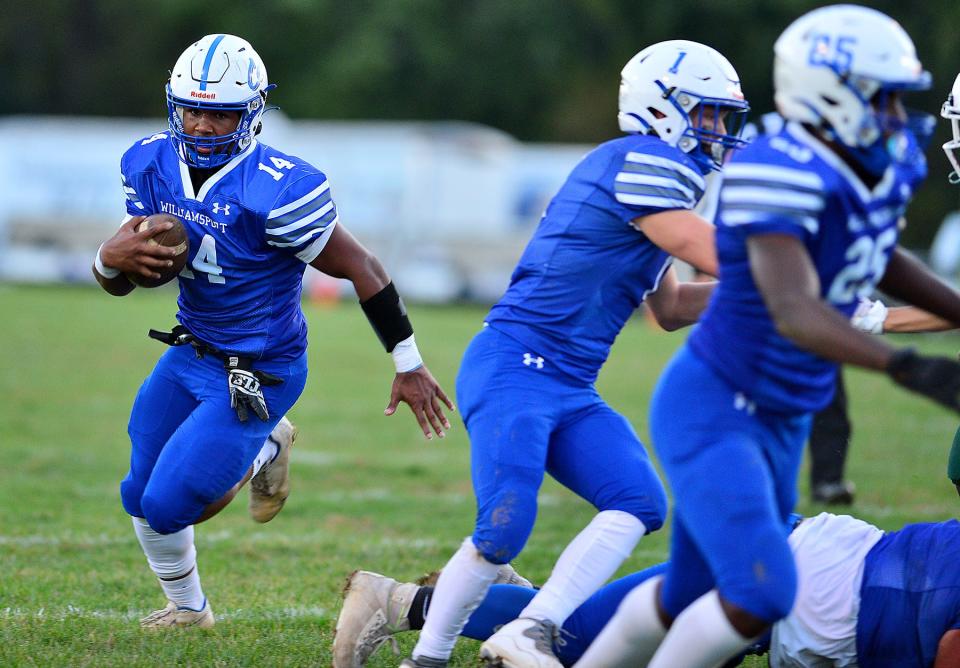Game plans give way to life in the moment, keeping football interesting, unpredictable
Football — like most sports — is not an exact science.
That’s not what anyone wants us to believe. There was a time when just watching and enjoying the game was enough.
Now, we have computer departments creating algorithms to figure out proper plays to be used at proper times, based on analytic tendencies.
Math departments work up percentages of success.

Heck, even the DMV is getting involved, using radar guns to show how fast balls are being thrown and the speed of runners.
Week 7 results:Boonsboro pulls away from North; Williamsport closes out South
Then there’s the unfathomable count of talking heads — i.e., expert analysts — trying to tell the world, with this pile of data, which team is going to win a game, why and by what score.
Many take that to the bank — or the nearest gaming site — in hopes of pulling off a monetary victory of their own.
The truth is, those guys don’t know it all. They allegedly are more informed, but they pick the games like the rest of us.
It’s not foolproof, especially in football.
There are times — even full weekends — when teams don’t always get what they want or expect. Games rarely go exactly as planned.
In those times, coaches, players and teams go off script to get what they need to win.

Can’t get what you want … try sometimes … get what you need. Sounds like a Rolling Stones song, doesn’t it?
There’s always an unsung hero or a quirky play in every contest. Those are the events that make good game stories interesting.
They prove — or disprove — all the algorithms, math, mph data and a myriad of analysis and opinions were just hype for the game.
A few wanted/needed switches popped up during a couple of games over the weekend.
The first came in Williamsport’s 21-7 win over South Hagerstown on Friday.
The Wildcats were confronted with what could’ve been a devastating problem. Williamsport lost starting quarterback Eli Fleming to injury a week earlier in a loss to North Hagerstown.
Basically, Williamsport’s ship became rudderless without Fleming. The Wildcats did what they could, but came up a point short against the Hubs in the 13-12 double-overtime defeat.
Without Fleming, the Wildcats got what they needed against South from Corry Nelson, a junior receiver who moved under center.
He couldn’t throw the ball as well as Fleming, but Nelson provided more physical running to help the Wildcats compensate for the setback. Williamsport maintained a 7-7 tie into halftime and through the third quarter.
But Williamsport also had a “Plan C” in its back hip pad.
Photos:South Hagerstown vs. Williamsport football
With 10 minutes remaining in the game, the Wildcats fully introduced a “Wildcat” formation, moving Nelson a few steps to the side of center to set up a direct-snap situation for running back Cole Rourke.
Rourke received the snap and took off. The offensive wrinkle proved to be the window dressing Williamsport needed to score two touchdowns in the final 7:30 to pull out the victory.
The next day, Shepherd hosted Millersville for a homecoming matchup that made the Rams’ faithful — both past and present — a bit uneasy.
Things weren’t coming easy for Shepherd, especially after coming off a 72-7 victory over Lock Haven a week earlier. The offense met a challenge on this weekend.
After Shepherd scored on its first two possessions, Millersville found a way to slow down the nationally-ranked Rams.
The Marauders used deep coverage to limit big-play options, forcing Shepherd to find a different avenue for success. Millersville baited Tyson Bagent, Shepherd’s All-American quarterback, into a pair of interceptions and a lost fumble.
Bagent wasn’t Bagent-like, to the disliking of many, but it thankfully didn’t reach the extent of Yankee fans booing Aaron Judge.
Millersville scored twice in 12 seconds during the last minute of the first half to shrink its deficit to 21-17 at halftime.
In the second half, Shepherd got what it needed.
Passes were shorter. The defense was tighter and got a second touchdown by defensive back Donte Harrison to get things rolling.
Running back Ronnie Brown made his presence felt with some jitterbug runs and a 76-yard TD gallop. Bagent ran one in, too.
The Rams outscored the Marauders 34-0 in the second half to improve to 7-0.
Shepherd took care of business, a little differently than usual, to get what it needed.
The Rams didn’t just face a challenge on the field (at least in the first half). The university's scoreboard decided to fritz out during the second quarter. The Rams’ score locked up and was inaccurately stuck at 14 for the rest of the first half.
A halftime reboot rightfully gave the Rams their 21-17 lead to start the second half, but shortly thereafter, the scoreboard started to look like one of those prediction algorithms we’re talking about.
Luckily, the clock remained functional and Millersville cooperated by not scoring for the rest of the game.
The needed information — down, distance and score — was conveyed to fans via the dulcet tones of PA announcer Paddy Alter’s voice.
In the end, Shepherd’s score appeared in the “Down” window of the scoreboard.
Shepherd made sure it wasn’t an issue in the 55-17 victory.
But it goes to show no one can accurately predict the exact storyline for any victory.
Even scoreboards need alternate ways to claim victories.
This article originally appeared on The Herald-Mail: Parasiliti: In football, what's wanted never outweighs what's needed

